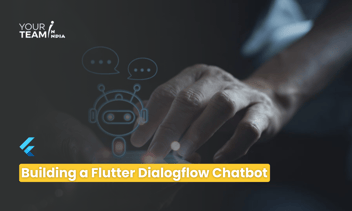Quick Summary: Dive into the fusion of Flutter and Blockchain to empower your development journey in creating Decentralized Apps (DApps). Explore the synergy of Flutter's cross-platform capabilities with the decentralized nature of blockchain, unlocking new possibilities for building innovative and secure applications in this dynamic technological convergence.
Introduction
Blockchain technology has transformed the way we think about data and digital transactions. With its decentralized and immutable nature, blockchain has opened up a world of possibilities, including developing decentralized applications (DApps).
Flutter, a popular framework for building mobile applications, is an excellent choice for creating DApps that leverage the power of blockchain technology. In this article, we'll explore the synergy between Flutter and blockchain and provide code snippets to help you start your journey to building DApps.
Understanding Blockchain and DApps
Before diving into the technical details of building DApps with Flutter, let's briefly understand the key concepts of blockchain and decentralized applications.
Blockchain: A blockchain is a distributed and immutable ledger that records transactions across a network of computers. Each block in the chain contains a group of transactions, and once added, it cannot be altered or deleted. This ensures data integrity and transparency, making it a trusted technology for various applications, including finance, supply chain, and more.
Decentralized Applications (DApps): DApps run on a blockchain network, leveraging its decentralized and trustless nature. Unlike traditional apps, DApps do not rely on a centralized server for data storage and processing. Instead, they use smart contracts and decentralized protocols for executing code and managing data.
Building DApps with Flutter
To build DApps with Flutter, you'll need to integrate your Flutter application with a blockchain network and use smart contracts to interact with the blockchain. Ethereum is a popular choice for DApp development due to its smart contract capabilities, but other blockchains like Binance Smart Chain, Polkadot, or Solana can also be used.
Here are the steps to get started with building DApps in Flutter:
- Set Up Your Development Environment: Ensure Flutter and Dart are installed on your development machine. You'll also need a code editor like Visual Studio Code to write Flutter code.
- Choose a Blockchain Network: Select a blockchain network you want to build your DApp on. For this article, we'll use Ethereum as an example.
- Connect to the Blockchain: Use a library like `web3dart` to connect your Flutter application to the Ethereum blockchain. This library allows you to interact with Ethereum using Dart.
|
import 'package:web3dart/web3dart.dart'; final httpLink = HttpLink('https://mainnet.infura.io/v3/your-infura-project-id'); final ethClient = Web3Client(httpLink, Client()); |
- Create a Smart Contract: Write or deploy a smart contract on the blockchain. You can use languages like Solidity to create your smart contracts. Interact with the contract using the `web3dart` library.
|
final contractAddress = EthereumAddress.fromHex('0xYourContractAddress'); final contract = DeployedContract( ContractAbi.fromJson('your_contract_abi_json'), contractAddress); |
- Build the Flutter User Interface: Create your Flutter UI with widgets to interact with the smart contract. For example, create buttons to trigger contract functions and display data from the blockchain.
- Handle Transactions: Use Flutter's async and await mechanism to handle transactions. Send transactions to the blockchain when users interact with your DApp.
|
final credentials = await ethClient.credentialsFromPrivateKey('your_private_key'); final transaction = Transaction( to: contractAddress, data: contract.function('your_contract_function').encode(<dynamic>[]), ); await ethClient.sendTransaction(credentials, transaction); |
- Test and Deploy: Test your DApp on a local Ethereum network or a testnet before deploying it to the mainnet. For deployment, you can use services like Infura.
- Security and Best Practices: Implement security measures, like checking user input and ensuring the security of private keys. Follow best practices for DApp development.
Conclusion
Building decentralized applications with Flutter and blockchain technology opens up exciting possibilities for creating secure, transparent, and trustless applications. Integrating Flutter with blockchain networks like Ethereum allows you to create DApps that offer unique features and benefits. This article provided a high-level overview of the process, including code snippets, to get you started on your journey to building DApps. Whether you're interested in financial services, supply chain management, or any other field, DApp development with Flutter and blockchain can be a game-changer for your project.
Ready to elevate your Flutter app design? Unlock the full potential of Flutter layouts with our professional Flutter developers.








